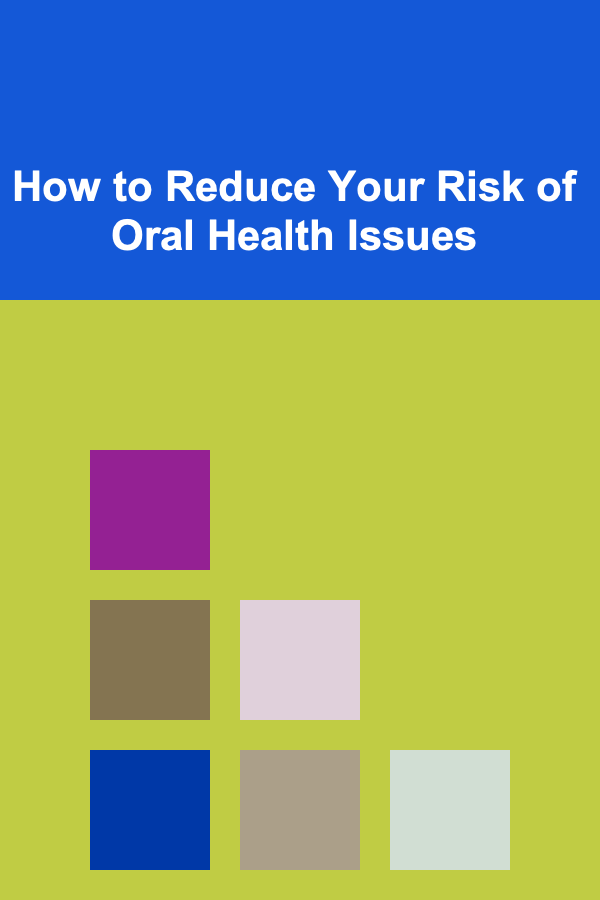
How to Reduce Your Risk of Oral Health Issues
ebook include PDF & Audio bundle (Micro Guide)
$12.99$8.99
Limited Time Offer! Order within the next:

Oral health is an integral part of overall health. Neglecting your teeth and gums can lead to a range of problems, from cavities and gum disease to more serious conditions affecting your heart, diabetes management, and even pregnancy. This comprehensive guide will delve into the various ways you can proactively reduce your risk of oral health issues and maintain a healthy, confident smile for years to come.
The Foundation: Proper Oral Hygiene Practices
The cornerstone of good oral health is a consistent and effective oral hygiene routine. This goes beyond a quick brush in the morning and before bed. Let's break down the essential components:
Brushing Techniques: The Right Way to Clean
Brushing is the first line of defense against plaque and bacteria. However, the way you brush is just as important as how often you do it. Consider these tips:
- Choose the Right Brush: Opt for a soft-bristled toothbrush. Medium or hard bristles can be too abrasive and damage your enamel and gums over time. Consider an electric toothbrush, which can be more effective at removing plaque. Look for the ADA Seal of Acceptance to ensure the toothbrush meets quality standards.
- Use Fluoride Toothpaste: Fluoride strengthens tooth enamel, making it more resistant to acid attacks from bacteria. Make sure your toothpaste contains fluoride.
- The Correct Technique: Place the toothbrush at a 45-degree angle to the gum line. Use gentle, short, back-and-forth strokes. Avoid scrubbing vigorously, which can wear away enamel and irritate gums.
- Reach All Surfaces: Brush all surfaces of each tooth -- the outer, inner, and chewing surfaces. Don't forget to brush your tongue to remove bacteria and freshen your breath.
- Timing is Key: Brush for at least two minutes, twice a day. Many electric toothbrushes have built-in timers to help you brush for the recommended duration.
- Replace Your Toothbrush Regularly: Replace your toothbrush every three to four months, or sooner if the bristles are frayed. Frayed bristles are less effective at cleaning and can harbor bacteria.
Flossing: Reaching Where Your Brush Can't
Flossing removes plaque and food particles from between your teeth and along the gum line, areas that your toothbrush can't reach. It's a critical step in preventing cavities and gum disease.
- The Proper Technique: Use about 18 inches of floss, wrapping most of it around your middle fingers and leaving a few inches to work with. Gently guide the floss between your teeth using a sawing motion. Once the floss is between your teeth, curve it into a "C" shape against one tooth and slide it up and down under the gum line. Repeat this process on the other side of the tooth.
- Be Gentle: Avoid snapping the floss into your gums, which can cause irritation and bleeding.
- Be Thorough: Floss between all of your teeth, including the back teeth.
- Frequency: Floss at least once a day, preferably before brushing. Flossing before brushing helps loosen plaque and food particles so that the toothbrush can remove them more effectively.
- Alternatives: If you find traditional floss difficult to use, consider using floss picks, interdental brushes, or a water flosser. These can be especially helpful if you have tight spaces between your teeth or braces.
Mouthwash: An Added Layer of Protection
Mouthwash can complement brushing and flossing by helping to kill bacteria, freshen breath, and strengthen enamel. However, it's not a substitute for proper brushing and flossing.
- Choose the Right Mouthwash: Look for a mouthwash that contains fluoride to help strengthen enamel. Antimicrobial mouthwashes can help kill bacteria and reduce plaque. If you have dry mouth, choose an alcohol-free mouthwash to avoid further drying out your mouth.
- How to Use Mouthwash: Rinse your mouth with mouthwash for 30 seconds after brushing and flossing. Do not swallow the mouthwash. Wait at least 30 minutes after rinsing before eating or drinking.
- Consult Your Dentist: Ask your dentist for recommendations on the best mouthwash for your specific needs. Some mouthwashes are designed to address specific issues like gingivitis or dry mouth.
Dietary Choices: Fueling a Healthy Mouth
What you eat and drink has a significant impact on your oral health. Certain foods and beverages can promote tooth decay and gum disease, while others can help protect your teeth.
Foods to Limit or Avoid: The Bad Guys
- Sugary Foods and Drinks: Sugar is the primary fuel for bacteria that cause tooth decay. Limit your intake of sugary foods and drinks, such as candy, soda, juice, and pastries. Be mindful of hidden sugars in processed foods.
- Acidic Foods and Drinks: Acid can erode tooth enamel, making your teeth more susceptible to decay. Limit your intake of acidic foods and drinks, such as citrus fruits, tomatoes, vinegar, and carbonated beverages. If you do consume acidic foods or drinks, rinse your mouth with water afterward.
- Sticky Foods: Sticky foods, such as caramels, gummy candies, and dried fruit, can cling to your teeth for extended periods, providing a constant source of fuel for bacteria.
- Starchy Foods: While not as directly harmful as sugar, starchy foods like bread, pasta, and chips can break down into sugars in the mouth, contributing to plaque formation.
Foods to Embrace: The Good Guys
- Water: Drinking plenty of water helps to wash away food particles and bacteria, keeping your mouth hydrated and healthy. Water also stimulates saliva production, which helps to neutralize acids and remineralize enamel.
- Fruits and Vegetables: Fruits and vegetables, especially crunchy ones like apples, carrots, and celery, can help to scrub your teeth clean and stimulate saliva production. They also provide essential vitamins and minerals for healthy gums and teeth.
- Dairy Products: Dairy products, such as milk, cheese, and yogurt, are rich in calcium and phosphorus, which are essential for strong teeth and bones. They also help to neutralize acids in the mouth.
- Lean Proteins: Lean proteins, such as chicken, fish, and beans, are important for building and repairing tissues, including gum tissue.
- Nuts and Seeds: Nuts and seeds are rich in minerals and healthy fats that are beneficial for oral health. Chewing nuts and seeds can also help to stimulate saliva production.
- Green Tea: Green tea contains antioxidants that can help to protect against gum disease and tooth decay.
Smart Snacking Habits
Snacking between meals can increase your risk of tooth decay if you're not careful. Choose healthy snacks like fruits, vegetables, nuts, or cheese. Avoid sugary or acidic snacks. If you do snack on something that could harm your teeth, rinse your mouth with water afterward.
Regular Dental Checkups: Prevention is Key
Regular dental checkups are essential for preventing and detecting oral health problems early. Your dentist can identify potential issues before they become serious and provide professional cleanings to remove plaque and tartar buildup.
The Importance of Professional Cleanings
Even with diligent brushing and flossing, it can be difficult to remove all plaque and tartar from your teeth, especially in hard-to-reach areas. A professional cleaning by a dentist or dental hygienist can remove these deposits and help prevent cavities and gum disease.
What to Expect During a Dental Checkup
A typical dental checkup includes:
- Examination: Your dentist will examine your teeth, gums, and mouth for signs of decay, gum disease, oral cancer, and other problems.
- Cleaning: A dental hygienist will clean your teeth, removing plaque and tartar buildup.
- X-rays: X-rays may be taken to detect hidden problems, such as cavities between teeth or bone loss.
- Fluoride Treatment: A fluoride treatment may be applied to strengthen your enamel.
- Discussion: Your dentist will discuss your oral health with you and recommend any necessary treatment.
How Often Should You See Your Dentist?
The American Dental Association recommends that most adults see their dentist for a checkup and cleaning every six months. However, your dentist may recommend more frequent visits if you have a higher risk of oral health problems, such as gum disease or a history of cavities. Individuals with certain medical conditions, like diabetes, may also need more frequent checkups.
Addressing Specific Risk Factors
Certain factors can increase your risk of developing oral health problems. Being aware of these risk factors and taking steps to address them can help you protect your oral health.
Smoking and Tobacco Use
Smoking and tobacco use are major risk factors for gum disease, oral cancer, and other oral health problems. Tobacco use weakens the immune system, making it harder for your body to fight off infections. It also reduces blood flow to the gums, hindering healing. Quitting smoking or other tobacco use is one of the best things you can do for your oral and overall health.
Dry Mouth (Xerostomia)
Saliva helps to neutralize acids, wash away food particles, and remineralize enamel. Dry mouth, or xerostomia, occurs when your mouth doesn't produce enough saliva, increasing your risk of tooth decay and gum disease. Dry mouth can be caused by certain medications, medical conditions, or treatments, such as radiation therapy.
- Managing Dry Mouth: Drink plenty of water, chew sugar-free gum, use an alcohol-free mouthwash, and talk to your dentist about saliva substitutes or medications that can stimulate saliva production.
Diabetes
People with diabetes are at a higher risk of developing gum disease. High blood sugar levels can weaken the immune system and make it harder for the body to fight off infections, including gum disease. Gum disease, in turn, can make it more difficult to control blood sugar levels. Maintaining good blood sugar control and practicing good oral hygiene are essential for people with diabetes.
Certain Medications
Some medications can cause dry mouth or other oral health problems. If you're taking any medications, talk to your dentist about potential side effects and how to manage them. Examples include antihistamines, decongestants, antidepressants, and high blood pressure medications.
Pregnancy
Hormonal changes during pregnancy can increase your risk of gum disease. It's important to maintain good oral hygiene during pregnancy and see your dentist regularly. Some studies even suggest a link between gum disease in pregnant women and premature birth and low birth weight babies.
Genetics
Genetics can play a role in your susceptibility to certain oral health problems, such as gum disease. If you have a family history of gum disease, you may be at a higher risk of developing it yourself. Talk to your dentist about your family history and what steps you can take to protect your oral health.
Grinding or Clenching Your Teeth (Bruxism)
Grinding or clenching your teeth, especially at night, can wear down your enamel, cause jaw pain, and lead to other dental problems. If you grind or clench your teeth, talk to your dentist about options such as a mouthguard to protect your teeth.
Advanced Oral Hygiene Techniques
For some individuals, standard brushing and flossing might not be sufficient. Consider these advanced techniques to further enhance your oral health:
Tongue Scraping
The tongue can harbor a significant amount of bacteria, contributing to bad breath and potentially impacting overall oral hygiene. Tongue scraping is a simple yet effective way to remove this bacteria. Use a tongue scraper or a toothbrush to gently scrape the surface of your tongue from back to front.
Interdental Brushes
For individuals with larger spaces between their teeth, interdental brushes can be more effective than floss at removing plaque and food particles. These small, cone-shaped brushes are designed to fit between teeth and clean the surfaces that floss might miss.
Water Flossers
Water flossers use a stream of pulsating water to remove plaque and food particles from between teeth and along the gum line. They can be a good option for people who have difficulty using traditional floss or who have braces or other dental appliances.
Recognizing the Signs and Symptoms
Being aware of the early signs and symptoms of oral health problems can help you seek treatment promptly and prevent them from becoming more serious. Watch out for:
- Bleeding Gums: Bleeding gums, especially when brushing or flossing, are a common sign of gum disease.
- Red, Swollen, or Tender Gums: Red, swollen, or tender gums are also signs of gum disease.
- Persistent Bad Breath: Persistent bad breath that doesn't go away with brushing and flossing can be a sign of gum disease or other oral health problems.
- Loose Teeth: Loose teeth are a sign of advanced gum disease.
- Pain When Chewing: Pain when chewing can be a sign of tooth decay, gum disease, or other problems.
- Sensitivity to Hot or Cold: Sensitivity to hot or cold can be a sign of tooth decay or enamel erosion.
- White Spots on Teeth: White spots on teeth can be a sign of early tooth decay.
- Mouth Sores: Sores in the mouth that don't heal within two weeks should be evaluated by a dentist.
Beyond the Basics: Lifestyle and Holistic Approaches
Your overall lifestyle choices extend beyond diet and directly influence oral health. Consider these holistic approaches:
Stress Management
Stress can contribute to teeth grinding and clenching, as well as weaken your immune system. Employ stress-reduction techniques like meditation, yoga, or deep breathing exercises to protect your teeth and gums.
Adequate Sleep
Sufficient sleep allows your body to repair and regenerate, which is crucial for immune function and overall health, including oral health. Aim for 7-8 hours of quality sleep per night.
Proper Hydration
As mentioned previously, water plays a critical role in saliva production and overall oral hygiene. Carry a water bottle and sip throughout the day, especially after meals.
Regular Exercise
Exercise improves circulation and reduces inflammation, both of which benefit gum health. Aim for at least 30 minutes of moderate-intensity exercise most days of the week.
Conclusion: A Lifelong Commitment to Oral Health
Reducing your risk of oral health issues is an ongoing process that requires a commitment to good oral hygiene practices, a healthy diet, regular dental checkups, and addressing any specific risk factors you may have. By taking proactive steps to care for your teeth and gums, you can enjoy a healthy, confident smile for a lifetime. Remember that consistency is key -- incorporating these practices into your daily routine will yield the best results. Consult with your dentist to create a personalized oral health plan tailored to your specific needs and concerns. Don't wait until you have a problem to prioritize your oral health; start taking care of your smile today!

How to Build a Checklist for Maintaining Consistency in Content Creation
Read More
How to Start Saving for a Vacation While Managing Your Home Budget
Read More
How to Style Your Entryway with Holiday Decor
Read More
How to Discover the Hidden Gems of Tokyo
Read More
Mastering Mess-Free Fluid Changes: A Comprehensive Guide to Using Funnels and Drain Pans
Read More
How to Build a Strong Relationship with Your Boss
Read MoreOther Products

How to Build a Checklist for Maintaining Consistency in Content Creation
Read More
How to Start Saving for a Vacation While Managing Your Home Budget
Read More
How to Style Your Entryway with Holiday Decor
Read More
How to Discover the Hidden Gems of Tokyo
Read More
Mastering Mess-Free Fluid Changes: A Comprehensive Guide to Using Funnels and Drain Pans
Read More